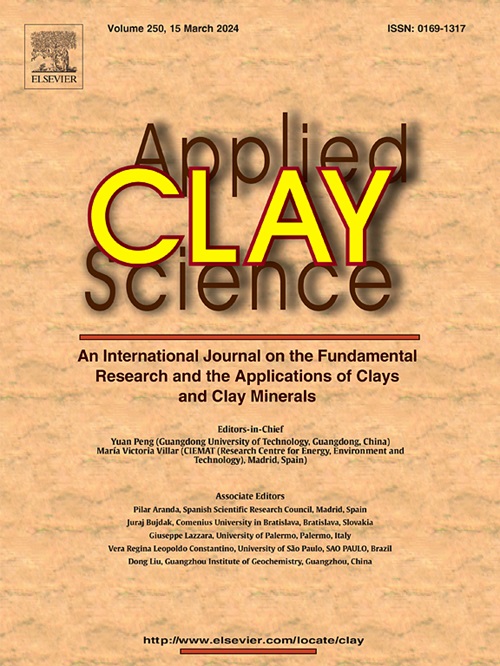利用非均质表面电荷和透明聚合物粒子调制高岭土纳米管在水中的自组装
IF 5.3
2区 地球科学
Q2 CHEMISTRY, PHYSICAL
引用次数: 0
摘要
高岭土粘土纳米管是研究水中分散颗粒胶体行为的可行模型。它们在水中表现出优异的胶体稳定性,因为它们具有很强的整体负表面电荷。我们对高岭土表面不均匀性进行了详细的表征,并对稀释后的高岭土水分散行为进行了现场观察。使用暗场显微镜,我们检测到单个高岭土棒之间的聚集,其行为与大多数非聚集的纳米颗粒不同。在光滑的高岭土表面上,带正电荷的斑块的随机分布有助于单个粘土纳米管的静电聚集成端到端和端到端的稳定聚集体。高岭土聚集的另一种模式是通过类似带电胶体的远距离吸引,归因于微量的透明外聚合物颗粒(TEP),无处不在的生物微凝胶,持续存在于去离子水中,并将单个高岭土桥接成长期协调的簇。这些聚集体证明了早先未知的水悬浮纳米级颗粒有机物质在类带电胶体的反直觉远程聚集中的作用。我们还发现微生物生物聚合物粘球吸引高岭土棒,形成不寻常的海胆样运动微结构,证实TEP参与天然胶体自组装。在无菌纯化去离子水中几乎检测不到的TEP的持续存在表明它们在纳米/微尺度过程中的重要作用。本文章由计算机程序翻译,如有差异,请以英文原文为准。

Self-assembly of halloysite nanotubes in water modulated via heterogeneous surface charge and transparent exopolymer particles
Halloysite clay nanotubes are a viable model to investigate the colloid behaviour of particles dispersed in water. They demonstrate excellent colloid stability in water due to the strong overall negative surface charge. We performed detailed characterisation of halloysite surface inhomogeneity and in situ observations of diluted halloysite water dispersions behaviour. Using dark-field microscopy, we detected an aggregation between individual halloysite rods, behaving unlike the bulk majority of the non-aggregating nanoparticles. The stochastic distribution of positively-charged patches on overall smooth halloysite surfaces facilitates the electrostatic clustering of individual clay nanotubes into stable aggregates having end-to-end and end-to-side configurations. Another pattern of halloysite aggregation through seemingly long-range attraction of like-charged colloids was attributed to trace amounts of transparent exopolymer particles (TEP), ubiquitous biogenic microgels, persisting in deionised water and bridging individual halloysites into long-standing coordinated clusters. These aggregates demonstrate the earlier unknown role of water-suspended nanoscale particulate organic matter in counterintuitive long-range aggregation of like-charged colloids. We also found that microbial biopolymer mucospheres attract halloysite rods, forming unusual sea urchin-like motile microstructures, confirming the participation of TEP in natural colloids self-assembly. The persistence of barely detectable amounts of TEP in sterile purified deionised water suggests their important role in nano/micro scale processes.
求助全文
通过发布文献求助,成功后即可免费获取论文全文。
去求助
来源期刊

Applied Clay Science
地学-矿物学
CiteScore
10.30
自引率
10.70%
发文量
289
审稿时长
39 days
期刊介绍:
Applied Clay Science aims to be an international journal attracting high quality scientific papers on clays and clay minerals, including research papers, reviews, and technical notes. The journal covers typical subjects of Fundamental and Applied Clay Science such as:
• Synthesis and purification
• Structural, crystallographic and mineralogical properties of clays and clay minerals
• Thermal properties of clays and clay minerals
• Physico-chemical properties including i) surface and interface properties; ii) thermodynamic properties; iii) mechanical properties
• Interaction with water, with polar and apolar molecules
• Colloidal properties and rheology
• Adsorption, Intercalation, Ionic exchange
• Genesis and deposits of clay minerals
• Geology and geochemistry of clays
• Modification of clays and clay minerals properties by thermal and physical treatments
• Modification by chemical treatments with organic and inorganic molecules(organoclays, pillared clays)
• Modification by biological microorganisms. etc...
 求助内容:
求助内容: 应助结果提醒方式:
应助结果提醒方式:


